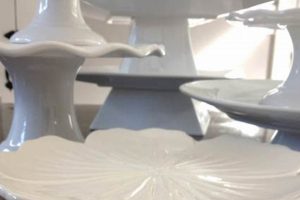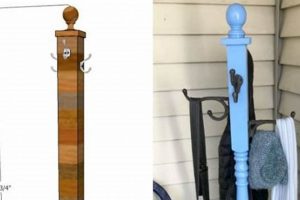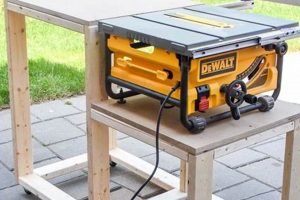The act of constructing a support structure for a stringed instrument, specifically a guitar, from lumber and through self-directed labor is a widespread practice. This undertaking typically involves employing basic carpentry skills and readily available tools to fabricate a holding device. The resulting item serves to elevate and protect the guitar when not in use.
Producing these supports offers several advantages. Economically, it can be significantly cheaper than purchasing a commercially manufactured alternative. It facilitates customization, allowing for dimensions and features precisely tailored to the guitar and the user’s needs. Historically, crafting such items has been a common woodworking project, embodying principles of resourcefulness and personalization.
The following sections will delve into specific design considerations, material selection criteria, step-by-step construction techniques, and finishing options relevant to this project.
Essential Considerations for Guitar Support Fabrication
The following guidelines offer critical insights for constructing a stable and protective support for a guitar. Attention to these details will enhance the functionality and longevity of the crafted item.
Tip 1: Material Selection: Opt for hardwoods like maple or oak for enhanced durability and resistance to wear. Softwoods, such as pine, may be suitable but require careful sealing and reinforcement to prevent dents or scratches.
Tip 2: Precise Measurements: Accurately measure the guitar’s lower bout width and body depth to ensure a secure and snug fit within the support. Inaccurate dimensions can compromise stability.
Tip 3: Secure Joinery: Employ robust joinery techniques such as mortise and tenon, dowel joints, or pocket-hole screws combined with wood glue. These methods will guarantee structural integrity and prevent wobbling.
Tip 4: Instrument Protection: Apply felt or leather padding to all contact points between the support and the guitar’s finish. This precaution minimizes the risk of scratches, dents, or chemical reactions.
Tip 5: Stable Base Design: Design a broad and stable base to prevent tipping. Consider a tripod or a wide A-frame configuration to maximize stability, particularly for heavier instruments.
Tip 6: Balanced Weight Distribution: Ensure the weight of the guitar is evenly distributed across the support structure. An unbalanced design can lead to instability and potential damage.
Tip 7: Smooth Finish: Sand all surfaces thoroughly to eliminate sharp edges or splinters that could scratch the instrument. Apply a durable, non-reactive finish such as polyurethane or lacquer to protect the wood.
These considerations will significantly enhance the quality and reliability of the guitar support. Prioritizing material quality, accurate measurements, secure joinery, instrument protection, and overall stability will result in a functional and aesthetically pleasing product.
The subsequent sections will explore specific design plans and detailed construction steps for creating a customized guitar support.
1. Wood Selection
The choice of lumber is a foundational element in the execution of a wooden guitar support. This decision directly influences the structural integrity, longevity, and aesthetic qualities of the final product. Employing hardwoods, such as maple, oak, or cherry, provides superior strength and resistance to wear compared to softwoods like pine or fir. The inherent density and grain structure of hardwoods better withstand the constant weight and pressure exerted by the supported instrument. A poorly chosen, structurally unsound wood species will compromise the stability of the completed support, increasing the risk of instrument damage.
Consider the scenario where a support is constructed using untreated pine. Over time, the pine may warp or splinter due to humidity fluctuations or the concentrated weight of the guitar. Conversely, a support crafted from kiln-dried maple, properly sealed and finished, will maintain its shape and structural integrity for an extended period. Additionally, the inherent visual characteristics of different wood species contribute to the overall appeal. A mahogany support, for instance, imparts a richer, more luxurious aesthetic compared to a utilitarian pine construction. Ultimately, the selection of the lumber dictates both the functional performance and the visual presentation of the finished support.
In summary, appropriate wood selection is not merely a cosmetic consideration, but a critical factor in ensuring the safety and durability of a guitar support. Overlooking this aspect can lead to structural failure and potential harm to the instrument. Prioritizing hardwoods and employing proper sealing and finishing techniques ensures a stable, long-lasting support that effectively protects the instrument it is designed to hold.
2. Design Stability
Design stability is a paramount factor in the successful execution of a guitar support constructed from wood. It directly influences the ability of the support to reliably hold the instrument without risk of tipping, collapsing, or otherwise failing. A poorly designed support, irrespective of the quality of materials used, presents a significant hazard to the guitar. The connection between design stability and the construction of a wooden guitar support is causal: inadequate design precipitates instability, potentially resulting in damage to the instrument.
The importance of design stability is exemplified by examining common failures. A narrow-based A-frame design, for instance, is inherently less stable than a tripod configuration. Similarly, a design lacking sufficient cross-bracing is susceptible to wobbling or lateral collapse. These examples demonstrate that even seemingly minor design flaws can compromise the overall stability of the support. Furthermore, the distribution of weight across the support structure must be carefully considered. An uneven distribution can lead to localized stress points, increasing the risk of failure.
In conclusion, design stability is a non-negotiable requirement for a functional and reliable wooden guitar support. A comprehensive understanding of structural mechanics and careful attention to design details are essential to prevent instrument damage and ensure the long-term usability of the constructed item. Neglecting design stability renders the entire construction effort futile, regardless of the quality of materials or craftsmanship employed.
3. Joint Strength
The structural integrity of a support fabricated from wood relies heavily on the strength of its joints. In the context of constructing a guitar support via self-directed labor, the integrity of these connections dictates the overall stability and load-bearing capacity of the structure. A weak joint compromises the entire assembly, rendering it susceptible to failure under the weight of the supported instrument. The correlation between joint strength and the practical success of a wooden guitar support is direct: insufficient joint strength inevitably leads to structural instability and potential instrument damage. For instance, a support utilizing butt joints secured only with nails or screws will likely fail under sustained load, whereas one employing mortise and tenon joints with adhesive reinforcement offers significantly enhanced durability.
Various joint types offer differing levels of resistance to shear and tensile forces. Dowel joints, pocket-hole screws combined with wood glue, and rabbet joints all represent viable options, each suited to specific load requirements and construction skills. The selection of an appropriate jointing technique must be informed by the anticipated stress on the support structure. Consider a support designed to hold a heavy bass guitar; such a design necessitates robust joints capable of withstanding substantial weight and preventing racking. Furthermore, the proper application of adhesive plays a critical role in maximizing joint strength, supplementing mechanical fasteners and creating a permanent bond between wood members. The alignment and surface preparation of joint components are also essential factors, impacting the overall effectiveness of the connection.
In summation, joint strength is a critical factor that impacts the longevity and safety of the guitar support. Careful consideration of joint type, fastener selection, adhesive application, and construction precision is crucial to ensure that the support is capable of securely holding the instrument. Neglecting this consideration poses a significant risk of structural failure, potentially leading to irreparable damage to the instrument. Therefore, proper joint construction is an indispensable component in the creation of a stable and reliable instrument support.
4. Finish Quality
The application of a protective and aesthetically pleasing coating to a self-constructed wooden guitar support is a critical step that influences the item’s durability, appearance, and the long-term protection of the instrument it holds. The finish quality directly affects the resistance of the wood to moisture, scratches, and other forms of damage, as well as the overall visual appeal of the finished product. Improper finishing techniques or the selection of inappropriate materials can compromise the structural integrity of the wood and potentially harm the guitar’s finish.
- Moisture Resistance
A high-quality finish forms a barrier against humidity and liquid spills, preventing the wood from warping, swelling, or developing mold. Finishes such as polyurethane or lacquer are effective in sealing the wood and minimizing moisture absorption. Conversely, an inadequate or absent finish allows moisture to penetrate the wood, leading to structural instability and potential damage to both the support and the guitar.
- Scratch and Abrasion Resistance
A durable finish protects the surface of the wooden support from scratches, dents, and abrasions that can occur during normal use. Hard finishes like catalyzed lacquer offer superior scratch resistance compared to softer finishes such as wax or oil. A well-applied finish preserves the appearance of the support and prevents minor damage from accumulating over time.
- Chemical Inertness
Certain finishes can react with the lacquer or varnish on a guitar, causing discoloration or damage. A chemically inert finish, such as polyurethane or a water-based acrylic, prevents these adverse reactions. Proper selection ensures the protection of the guitar’s finish when in contact with the support.
- Aesthetic Enhancement
The finish contributes significantly to the aesthetic appeal of the wooden support. Options range from clear finishes that highlight the natural grain of the wood to opaque coatings that provide a uniform color. The choice of finish depends on the desired aesthetic and the overall design of the support. A professionally applied finish enhances the visual quality of the support, making it a more attractive and functional addition to the instrument’s environment.
The quality of the finish is an integral element in the overall design and functionality. A carefully chosen and properly applied finish not only protects the wooden structure from environmental damage and physical wear but also ensures compatibility with the instrument itself, while enhancing the visual appeal of the final product. Therefore, the process of selecting and applying a finish should be approached with careful consideration and attention to detail to ensure a long-lasting and aesthetically pleasing outcome.
5. Padding Material
The selection and application of padding material are crucial steps in the construction of a support from lumber designed to hold a guitar. Padding acts as a protective interface between the rigid wood structure and the instrument’s delicate finish, mitigating potential damage from abrasion, pressure, or chemical reactions.
- Protection Against Scratches and Abrasions
Padding material minimizes the risk of scratches and abrasions to the guitar’s finish. Materials such as felt, velvet, or specialized foam provide a soft, non-abrasive surface that prevents the direct contact of wood with the instrument’s lacquer. For instance, strategically placed felt strips on the support’s contact points prevent scratches during placement and removal of the guitar.
- Impact Absorption and Pressure Distribution
Padding absorbs minor impacts and distributes pressure evenly across the guitar’s surface. This helps to prevent dents, pressure marks, and other forms of damage. Closed-cell foam, for example, offers excellent impact absorption and can be easily shaped to conform to the contours of the guitar’s body, ensuring uniform support.
- Prevention of Chemical Reactions
Certain padding materials can prevent chemical reactions between the wood finish and the guitar’s lacquer. Some wood finishes, particularly those containing volatile organic compounds, can react with certain types of lacquer, causing discoloration or damage. Inert materials such as archival-quality felt or polyethylene foam are less likely to cause these reactions, providing a safe barrier between the support and the instrument.
- Enhanced Stability and Grip
Padding can enhance the stability of the guitar within the support by providing increased friction and grip. Materials such as suede or rubberized foam offer a non-slip surface that prevents the guitar from sliding or shifting within the support, particularly on uneven surfaces. This enhanced stability reduces the risk of accidental falls or damage.
In summary, the careful selection and application of padding material are essential for ensuring the long-term protection and stability of a guitar supported by a self-constructed wood structure. The correct materials offer a critical barrier against physical and chemical damage, while also enhancing the overall functionality and aesthetic appeal of the finished product.
6. Accurate Dimensions
Precise measurement is a foundational element in the successful creation of a wooden guitar support. Deviations from accurate dimensions can compromise the structural integrity, stability, and protective function of the finished product. The following points outline the critical facets of dimensional accuracy in this context.
- Guitar Body Fit
The internal dimensions of the support must precisely accommodate the guitar’s body. Incorrect width or depth measurements can result in a support that is either too tight, risking damage to the instrument’s finish, or too loose, leading to instability and potential falls. For example, a support designed for a dreadnought guitar will not adequately secure a smaller parlor guitar due to dimensional discrepancies.
- Structural Component Alignment
Accurate dimensions are essential for the proper alignment of structural components. Mismatched lengths or angles in the support’s frame can create stress points and weaken the overall structure. Consider the leg assembly of an A-frame support; dimensional inaccuracies will cause uneven weight distribution and reduce stability.
- Padding Placement
Precise measurements dictate the placement and size of padding materials. Improperly sized or positioned padding offers inadequate protection, increasing the risk of scratches or pressure marks on the guitar. For instance, if padding is not precisely aligned with the guitar’s lower bout, the exposed wood can cause abrasion.
- Joint Integrity
Accurate dimensions are critical for the successful execution of joinery techniques. Imprecise cuts will compromise the strength and stability of joints, leading to structural failure over time. A mortise and tenon joint, for example, requires precise dimensions to ensure a tight, secure fit that can withstand the weight of the instrument.
The foregoing points underscore the importance of dimensional accuracy in every stage of construction. Accurate measurements are not merely a matter of aesthetics but are integral to the functionality, safety, and longevity of the completed item. Neglecting dimensional accuracy can result in a support that is unstable, damaging to the instrument, or structurally unsound, thereby defeating the purpose of the self-directed construction effort.
Frequently Asked Questions
The following section addresses common queries and concerns regarding the self-directed construction of instrument supports from lumber.
Question 1: What wood species are most suitable for constructing a robust and durable guitar support?
Hardwoods, such as maple, oak, or cherry, are generally preferred for their strength and resistance to wear. Softwoods, such as pine, may be used but require careful sealing and reinforcement.
Question 2: What joinery techniques are recommended for ensuring the structural integrity of a wooden guitar support?
Mortise and tenon joints, dowel joints, or pocket-hole screws combined with wood glue are all viable options, providing robust connections that can withstand the weight of the instrument.
Question 3: What type of padding material should be used to protect the guitar’s finish from scratches or chemical reactions?
Felt, velvet, or specialized closed-cell foam are suitable padding materials. Archival-quality felt or polyethylene foam are less likely to cause chemical reactions with the guitar’s finish.
Question 4: How can one ensure that the guitar support is stable and does not tip over easily?
A wide base, such as a tripod or A-frame configuration, provides enhanced stability. Proper weight distribution and a low center of gravity also contribute to a more stable design.
Question 5: What type of finish should be applied to the completed guitar support?
Durable, non-reactive finishes, such as polyurethane or lacquer, protect the wood from moisture and scratches. Ensure that the finish is fully cured before placing the guitar on the support.
Question 6: How can one accurately measure the guitar to ensure a proper fit within the wooden support?
Measure the guitar’s lower bout width and body depth precisely. Allow for slight tolerances to prevent the support from being too tight, but ensure a snug fit to prevent instability.
These frequently asked questions provide a comprehensive overview of the key considerations in the construction of the item in question. Attention to these details will enhance the overall quality and reliability of the finished product.
The next section will explore specific design options for this project.
Concluding Remarks
This exploration of wooden guitar stand diy has emphasized the crucial aspects of material selection, design stability, joint strength, finish quality, padding material, and accurate dimensions. These factors coalesce to determine the functionality and longevity of a self-constructed support, as well as the safety of the supported instrument. The information presented serves as a resource for informed decision-making throughout the crafting process.
Effective implementation of these principles transforms raw materials into a reliable and aesthetically pleasing instrument support. Continued diligence and a commitment to quality craftsmanship will yield a valuable and enduring asset for any guitar enthusiast.







